Corporate Reporting and Financial Analysis of BHP Billiton Company
VerifiedAdded on 2023/06/11
|12
|3288
|252
AI Summary
This paper examines the corporate reporting and financial analysis of BHP Billiton Company, a multinational mineral resources mining company headquartered in Melbourne, Australia. It discusses the qualitative characteristics of BHP Billiton's annual reports, including their relevance, comparability, and completeness of financial statements and sustainability reports. The paper also looks at sustainability reporting by BHP Billiton and provides recommendations to the management of the company regarding disclosure issues. Additionally, the paper discusses the purpose of pre-acquisition entries in the preparation of consolidated financial statements, the existence of dividends payable during the acquisition date, the necessity of distinguishing between pre-acquisition dividends and post-acquisition dividends, and goodwill during the acquisition date.
Contribute Materials
Your contribution can guide someone’s learning journey. Share your
documents today.
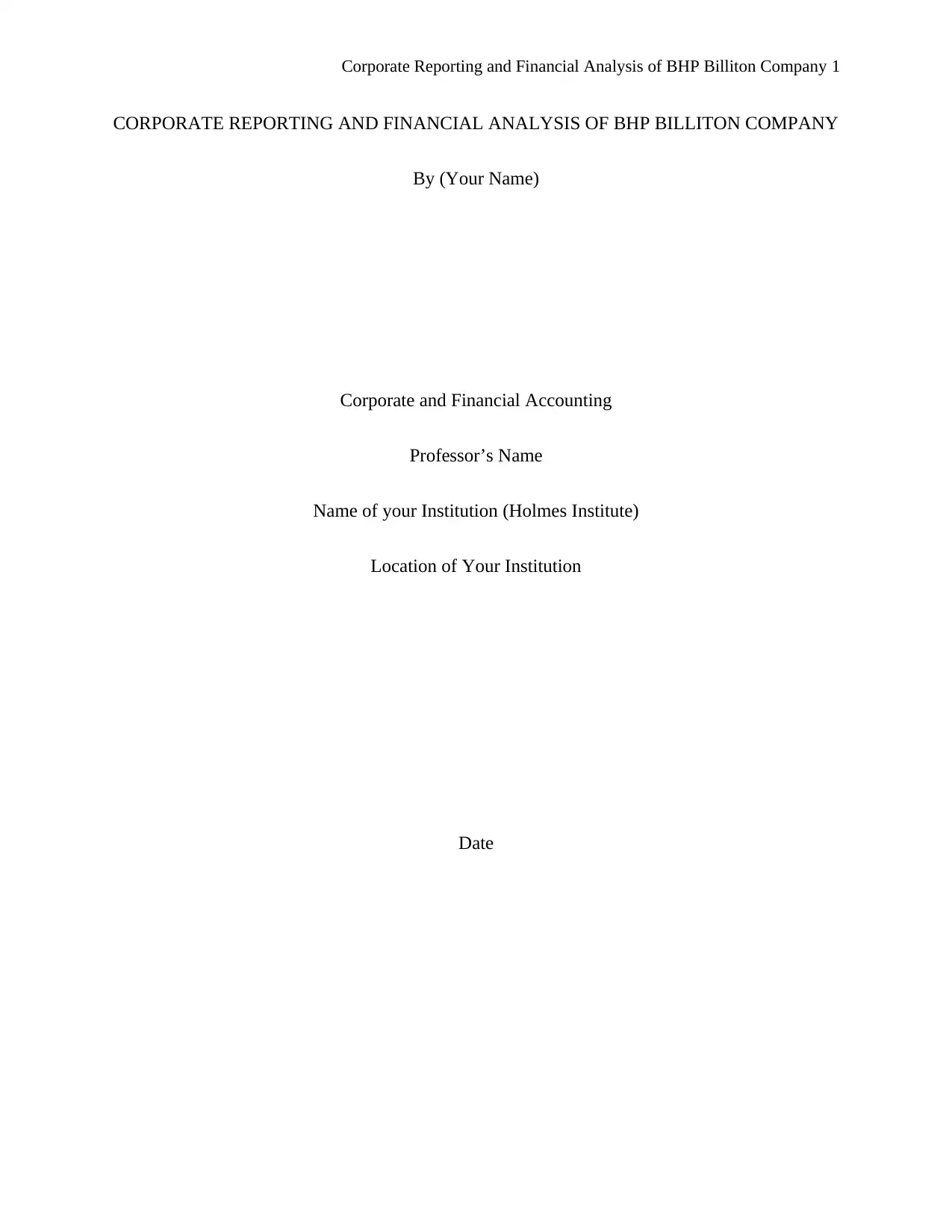
Corporate Reporting and Financial Analysis of BHP Billiton Company 1
CORPORATE REPORTING AND FINANCIAL ANALYSIS OF BHP BILLITON COMPANY
By (Your Name)
Corporate and Financial Accounting
Professor’s Name
Name of your Institution (Holmes Institute)
Location of Your Institution
Date
CORPORATE REPORTING AND FINANCIAL ANALYSIS OF BHP BILLITON COMPANY
By (Your Name)
Corporate and Financial Accounting
Professor’s Name
Name of your Institution (Holmes Institute)
Location of Your Institution
Date
Secure Best Marks with AI Grader
Need help grading? Try our AI Grader for instant feedback on your assignments.

Corporate Reporting and Financial Analysis of BHP Billiton Company 2
Corporate Reporting and Financial Analysis of BHP Billiton Company
Executive Summary
BHP Billiton is a multinational mineral resources mining company that is headquartered
in Melbourne, Australia. Having it roots dating back to 1885 at a mining town called Broken
Hill, the company has been dealing with the mining of metals such as iron ore, copper, Uranium
and Metallurgical coal and petroleum. BHP is listed on the Australian Stock Exchange (ASX)
and it as Australia's third largest company by revenue and first by market capitalization. BHP is
divided into a number of segments including the Coal segment, copper segment, petroleum
segment and Iron ore segment.
The coal segment deals with the mining of thermal coal and metallurgical coal while the
copper segment is engaged with the extraction of lead, zinc, uranium-molybdenum and gold. The
company operates mainly in Australia and America where it extracts mineral ores and gases from
areas where it owns mineral reserves. When it comes to market, BHP has a wide market
coverage in Australia, USA and all over the world where its target customers are reached through
direct supply agreements and global commodity exchange chains. On matters of financial and
sustainability disclosure, BHP Billiton has been on the front line in reporting financial,
sustainability and corporate social responsibility practices according to the expected standards.
The reporting has been bringing a lot of positive impact on the reputation of the company, apart
from the major Sermarco dam disaster that really discredited its image in 2015. Nonetheless, the
corporation has been determined to put health and safety of the workers and the community
ahead trough environmental responsibility by supporting the communities in environmental
conversation.
Corporate Reporting and Financial Analysis of BHP Billiton Company
Executive Summary
BHP Billiton is a multinational mineral resources mining company that is headquartered
in Melbourne, Australia. Having it roots dating back to 1885 at a mining town called Broken
Hill, the company has been dealing with the mining of metals such as iron ore, copper, Uranium
and Metallurgical coal and petroleum. BHP is listed on the Australian Stock Exchange (ASX)
and it as Australia's third largest company by revenue and first by market capitalization. BHP is
divided into a number of segments including the Coal segment, copper segment, petroleum
segment and Iron ore segment.
The coal segment deals with the mining of thermal coal and metallurgical coal while the
copper segment is engaged with the extraction of lead, zinc, uranium-molybdenum and gold. The
company operates mainly in Australia and America where it extracts mineral ores and gases from
areas where it owns mineral reserves. When it comes to market, BHP has a wide market
coverage in Australia, USA and all over the world where its target customers are reached through
direct supply agreements and global commodity exchange chains. On matters of financial and
sustainability disclosure, BHP Billiton has been on the front line in reporting financial,
sustainability and corporate social responsibility practices according to the expected standards.
The reporting has been bringing a lot of positive impact on the reputation of the company, apart
from the major Sermarco dam disaster that really discredited its image in 2015. Nonetheless, the
corporation has been determined to put health and safety of the workers and the community
ahead trough environmental responsibility by supporting the communities in environmental
conversation.
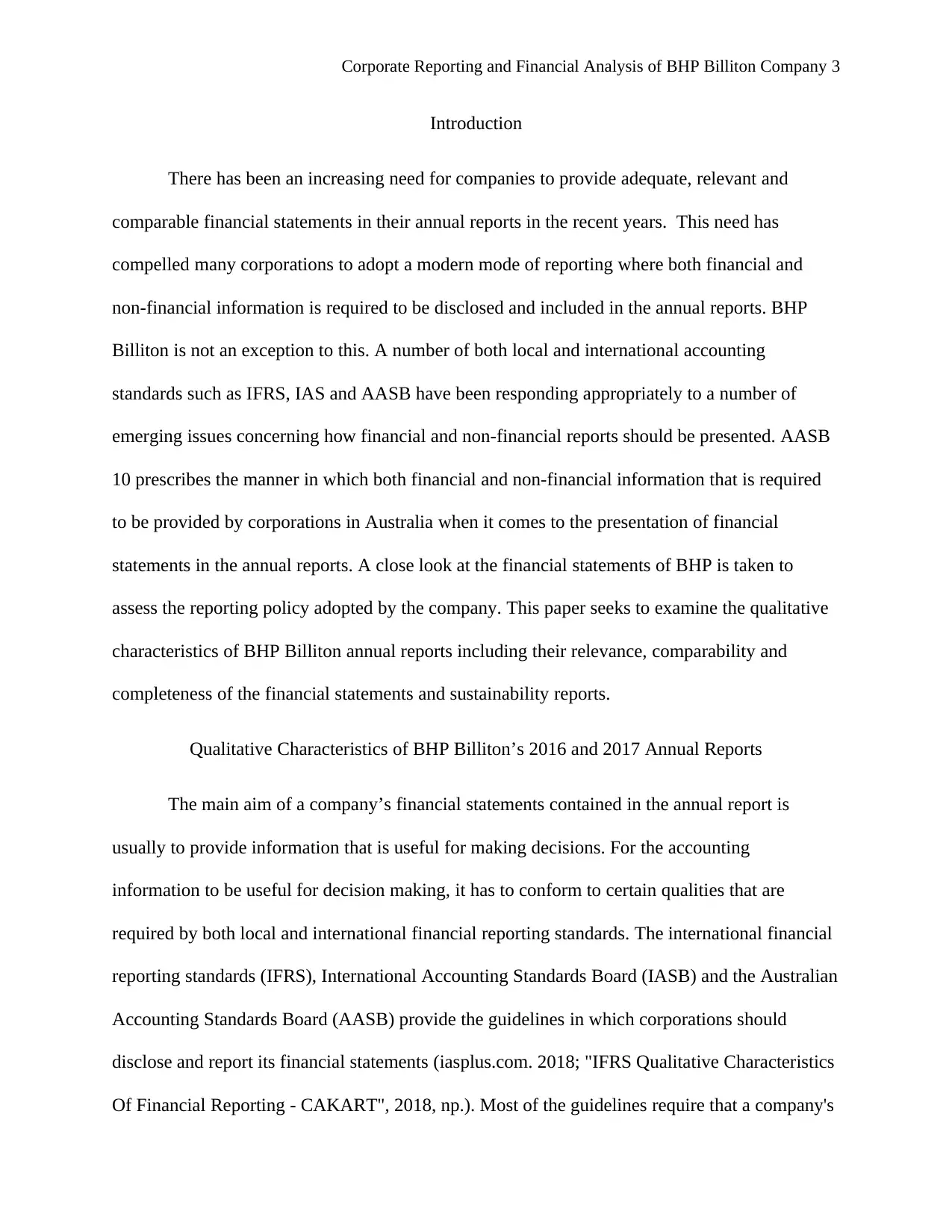
Corporate Reporting and Financial Analysis of BHP Billiton Company 3
Introduction
There has been an increasing need for companies to provide adequate, relevant and
comparable financial statements in their annual reports in the recent years. This need has
compelled many corporations to adopt a modern mode of reporting where both financial and
non-financial information is required to be disclosed and included in the annual reports. BHP
Billiton is not an exception to this. A number of both local and international accounting
standards such as IFRS, IAS and AASB have been responding appropriately to a number of
emerging issues concerning how financial and non-financial reports should be presented. AASB
10 prescribes the manner in which both financial and non-financial information that is required
to be provided by corporations in Australia when it comes to the presentation of financial
statements in the annual reports. A close look at the financial statements of BHP is taken to
assess the reporting policy adopted by the company. This paper seeks to examine the qualitative
characteristics of BHP Billiton annual reports including their relevance, comparability and
completeness of the financial statements and sustainability reports.
Qualitative Characteristics of BHP Billiton’s 2016 and 2017 Annual Reports
The main aim of a company’s financial statements contained in the annual report is
usually to provide information that is useful for making decisions. For the accounting
information to be useful for decision making, it has to conform to certain qualities that are
required by both local and international financial reporting standards. The international financial
reporting standards (IFRS), International Accounting Standards Board (IASB) and the Australian
Accounting Standards Board (AASB) provide the guidelines in which corporations should
disclose and report its financial statements (iasplus.com. 2018; "IFRS Qualitative Characteristics
Of Financial Reporting - CAKART", 2018, np.). Most of the guidelines require that a company's
Introduction
There has been an increasing need for companies to provide adequate, relevant and
comparable financial statements in their annual reports in the recent years. This need has
compelled many corporations to adopt a modern mode of reporting where both financial and
non-financial information is required to be disclosed and included in the annual reports. BHP
Billiton is not an exception to this. A number of both local and international accounting
standards such as IFRS, IAS and AASB have been responding appropriately to a number of
emerging issues concerning how financial and non-financial reports should be presented. AASB
10 prescribes the manner in which both financial and non-financial information that is required
to be provided by corporations in Australia when it comes to the presentation of financial
statements in the annual reports. A close look at the financial statements of BHP is taken to
assess the reporting policy adopted by the company. This paper seeks to examine the qualitative
characteristics of BHP Billiton annual reports including their relevance, comparability and
completeness of the financial statements and sustainability reports.
Qualitative Characteristics of BHP Billiton’s 2016 and 2017 Annual Reports
The main aim of a company’s financial statements contained in the annual report is
usually to provide information that is useful for making decisions. For the accounting
information to be useful for decision making, it has to conform to certain qualities that are
required by both local and international financial reporting standards. The international financial
reporting standards (IFRS), International Accounting Standards Board (IASB) and the Australian
Accounting Standards Board (AASB) provide the guidelines in which corporations should
disclose and report its financial statements (iasplus.com. 2018; "IFRS Qualitative Characteristics
Of Financial Reporting - CAKART", 2018, np.). Most of the guidelines require that a company's
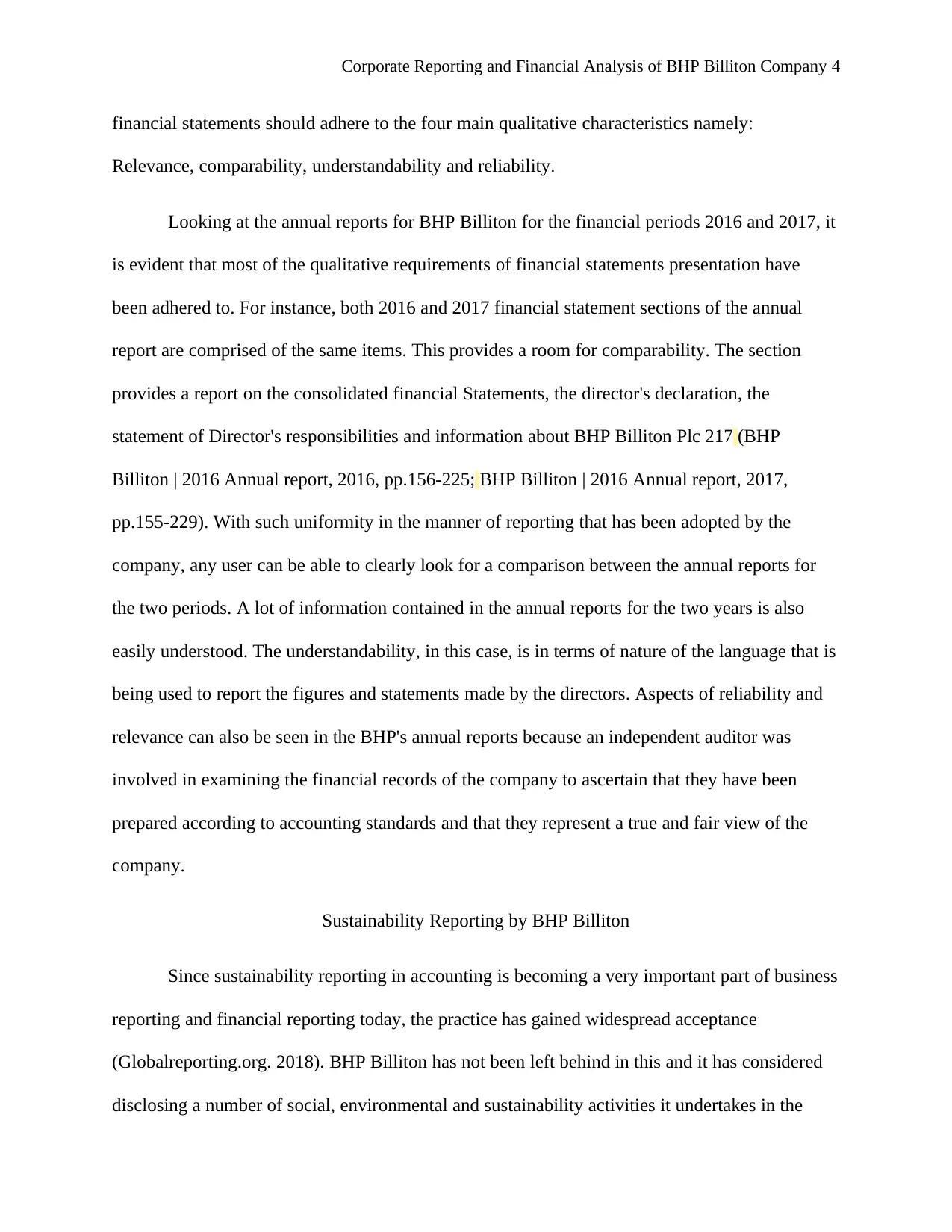
Corporate Reporting and Financial Analysis of BHP Billiton Company 4
financial statements should adhere to the four main qualitative characteristics namely:
Relevance, comparability, understandability and reliability.
Looking at the annual reports for BHP Billiton for the financial periods 2016 and 2017, it
is evident that most of the qualitative requirements of financial statements presentation have
been adhered to. For instance, both 2016 and 2017 financial statement sections of the annual
report are comprised of the same items. This provides a room for comparability. The section
provides a report on the consolidated financial Statements, the director's declaration, the
statement of Director's responsibilities and information about BHP Billiton Plc 217 (BHP
Billiton | 2016 Annual report, 2016, pp.156-225; BHP Billiton | 2016 Annual report, 2017,
pp.155-229). With such uniformity in the manner of reporting that has been adopted by the
company, any user can be able to clearly look for a comparison between the annual reports for
the two periods. A lot of information contained in the annual reports for the two years is also
easily understood. The understandability, in this case, is in terms of nature of the language that is
being used to report the figures and statements made by the directors. Aspects of reliability and
relevance can also be seen in the BHP's annual reports because an independent auditor was
involved in examining the financial records of the company to ascertain that they have been
prepared according to accounting standards and that they represent a true and fair view of the
company.
Sustainability Reporting by BHP Billiton
Since sustainability reporting in accounting is becoming a very important part of business
reporting and financial reporting today, the practice has gained widespread acceptance
(Globalreporting.org. 2018). BHP Billiton has not been left behind in this and it has considered
disclosing a number of social, environmental and sustainability activities it undertakes in the
financial statements should adhere to the four main qualitative characteristics namely:
Relevance, comparability, understandability and reliability.
Looking at the annual reports for BHP Billiton for the financial periods 2016 and 2017, it
is evident that most of the qualitative requirements of financial statements presentation have
been adhered to. For instance, both 2016 and 2017 financial statement sections of the annual
report are comprised of the same items. This provides a room for comparability. The section
provides a report on the consolidated financial Statements, the director's declaration, the
statement of Director's responsibilities and information about BHP Billiton Plc 217 (BHP
Billiton | 2016 Annual report, 2016, pp.156-225; BHP Billiton | 2016 Annual report, 2017,
pp.155-229). With such uniformity in the manner of reporting that has been adopted by the
company, any user can be able to clearly look for a comparison between the annual reports for
the two periods. A lot of information contained in the annual reports for the two years is also
easily understood. The understandability, in this case, is in terms of nature of the language that is
being used to report the figures and statements made by the directors. Aspects of reliability and
relevance can also be seen in the BHP's annual reports because an independent auditor was
involved in examining the financial records of the company to ascertain that they have been
prepared according to accounting standards and that they represent a true and fair view of the
company.
Sustainability Reporting by BHP Billiton
Since sustainability reporting in accounting is becoming a very important part of business
reporting and financial reporting today, the practice has gained widespread acceptance
(Globalreporting.org. 2018). BHP Billiton has not been left behind in this and it has considered
disclosing a number of social, environmental and sustainability activities it undertakes in the
Secure Best Marks with AI Grader
Need help grading? Try our AI Grader for instant feedback on your assignments.
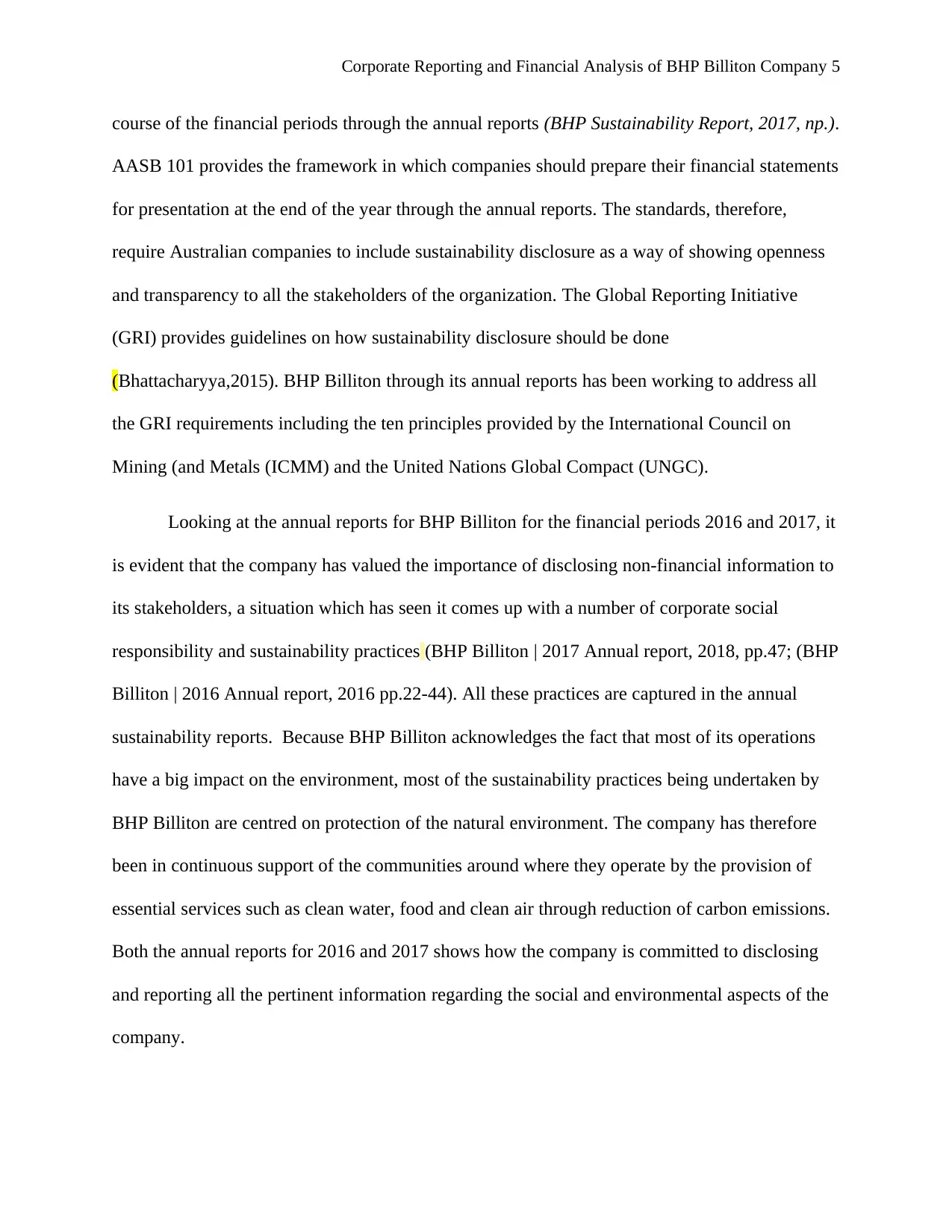
Corporate Reporting and Financial Analysis of BHP Billiton Company 5
course of the financial periods through the annual reports (BHP Sustainability Report, 2017, np.).
AASB 101 provides the framework in which companies should prepare their financial statements
for presentation at the end of the year through the annual reports. The standards, therefore,
require Australian companies to include sustainability disclosure as a way of showing openness
and transparency to all the stakeholders of the organization. The Global Reporting Initiative
(GRI) provides guidelines on how sustainability disclosure should be done
(Bhattacharyya,2015). BHP Billiton through its annual reports has been working to address all
the GRI requirements including the ten principles provided by the International Council on
Mining (and Metals (ICMM) and the United Nations Global Compact (UNGC).
Looking at the annual reports for BHP Billiton for the financial periods 2016 and 2017, it
is evident that the company has valued the importance of disclosing non-financial information to
its stakeholders, a situation which has seen it comes up with a number of corporate social
responsibility and sustainability practices (BHP Billiton | 2017 Annual report, 2018, pp.47; (BHP
Billiton | 2016 Annual report, 2016 pp.22-44). All these practices are captured in the annual
sustainability reports. Because BHP Billiton acknowledges the fact that most of its operations
have a big impact on the environment, most of the sustainability practices being undertaken by
BHP Billiton are centred on protection of the natural environment. The company has therefore
been in continuous support of the communities around where they operate by the provision of
essential services such as clean water, food and clean air through reduction of carbon emissions.
Both the annual reports for 2016 and 2017 shows how the company is committed to disclosing
and reporting all the pertinent information regarding the social and environmental aspects of the
company.
course of the financial periods through the annual reports (BHP Sustainability Report, 2017, np.).
AASB 101 provides the framework in which companies should prepare their financial statements
for presentation at the end of the year through the annual reports. The standards, therefore,
require Australian companies to include sustainability disclosure as a way of showing openness
and transparency to all the stakeholders of the organization. The Global Reporting Initiative
(GRI) provides guidelines on how sustainability disclosure should be done
(Bhattacharyya,2015). BHP Billiton through its annual reports has been working to address all
the GRI requirements including the ten principles provided by the International Council on
Mining (and Metals (ICMM) and the United Nations Global Compact (UNGC).
Looking at the annual reports for BHP Billiton for the financial periods 2016 and 2017, it
is evident that the company has valued the importance of disclosing non-financial information to
its stakeholders, a situation which has seen it comes up with a number of corporate social
responsibility and sustainability practices (BHP Billiton | 2017 Annual report, 2018, pp.47; (BHP
Billiton | 2016 Annual report, 2016 pp.22-44). All these practices are captured in the annual
sustainability reports. Because BHP Billiton acknowledges the fact that most of its operations
have a big impact on the environment, most of the sustainability practices being undertaken by
BHP Billiton are centred on protection of the natural environment. The company has therefore
been in continuous support of the communities around where they operate by the provision of
essential services such as clean water, food and clean air through reduction of carbon emissions.
Both the annual reports for 2016 and 2017 shows how the company is committed to disclosing
and reporting all the pertinent information regarding the social and environmental aspects of the
company.
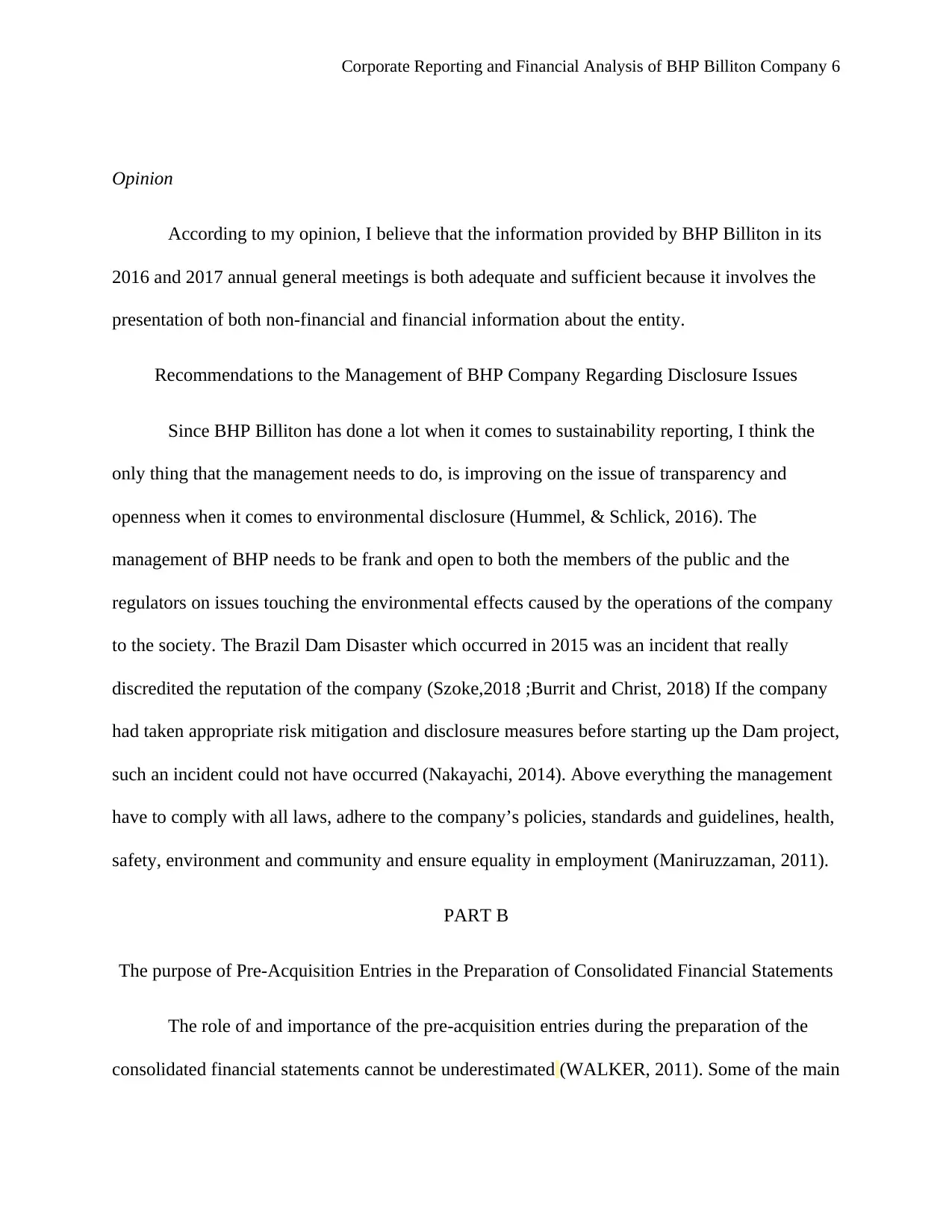
Corporate Reporting and Financial Analysis of BHP Billiton Company 6
Opinion
According to my opinion, I believe that the information provided by BHP Billiton in its
2016 and 2017 annual general meetings is both adequate and sufficient because it involves the
presentation of both non-financial and financial information about the entity.
Recommendations to the Management of BHP Company Regarding Disclosure Issues
Since BHP Billiton has done a lot when it comes to sustainability reporting, I think the
only thing that the management needs to do, is improving on the issue of transparency and
openness when it comes to environmental disclosure (Hummel, & Schlick, 2016). The
management of BHP needs to be frank and open to both the members of the public and the
regulators on issues touching the environmental effects caused by the operations of the company
to the society. The Brazil Dam Disaster which occurred in 2015 was an incident that really
discredited the reputation of the company (Szoke,2018 ;Burrit and Christ, 2018) If the company
had taken appropriate risk mitigation and disclosure measures before starting up the Dam project,
such an incident could not have occurred (Nakayachi, 2014). Above everything the management
have to comply with all laws, adhere to the company’s policies, standards and guidelines, health,
safety, environment and community and ensure equality in employment (Maniruzzaman, 2011).
PART B
The purpose of Pre-Acquisition Entries in the Preparation of Consolidated Financial Statements
The role of and importance of the pre-acquisition entries during the preparation of the
consolidated financial statements cannot be underestimated (WALKER, 2011). Some of the main
Opinion
According to my opinion, I believe that the information provided by BHP Billiton in its
2016 and 2017 annual general meetings is both adequate and sufficient because it involves the
presentation of both non-financial and financial information about the entity.
Recommendations to the Management of BHP Company Regarding Disclosure Issues
Since BHP Billiton has done a lot when it comes to sustainability reporting, I think the
only thing that the management needs to do, is improving on the issue of transparency and
openness when it comes to environmental disclosure (Hummel, & Schlick, 2016). The
management of BHP needs to be frank and open to both the members of the public and the
regulators on issues touching the environmental effects caused by the operations of the company
to the society. The Brazil Dam Disaster which occurred in 2015 was an incident that really
discredited the reputation of the company (Szoke,2018 ;Burrit and Christ, 2018) If the company
had taken appropriate risk mitigation and disclosure measures before starting up the Dam project,
such an incident could not have occurred (Nakayachi, 2014). Above everything the management
have to comply with all laws, adhere to the company’s policies, standards and guidelines, health,
safety, environment and community and ensure equality in employment (Maniruzzaman, 2011).
PART B
The purpose of Pre-Acquisition Entries in the Preparation of Consolidated Financial Statements
The role of and importance of the pre-acquisition entries during the preparation of the
consolidated financial statements cannot be underestimated (WALKER, 2011). Some of the main
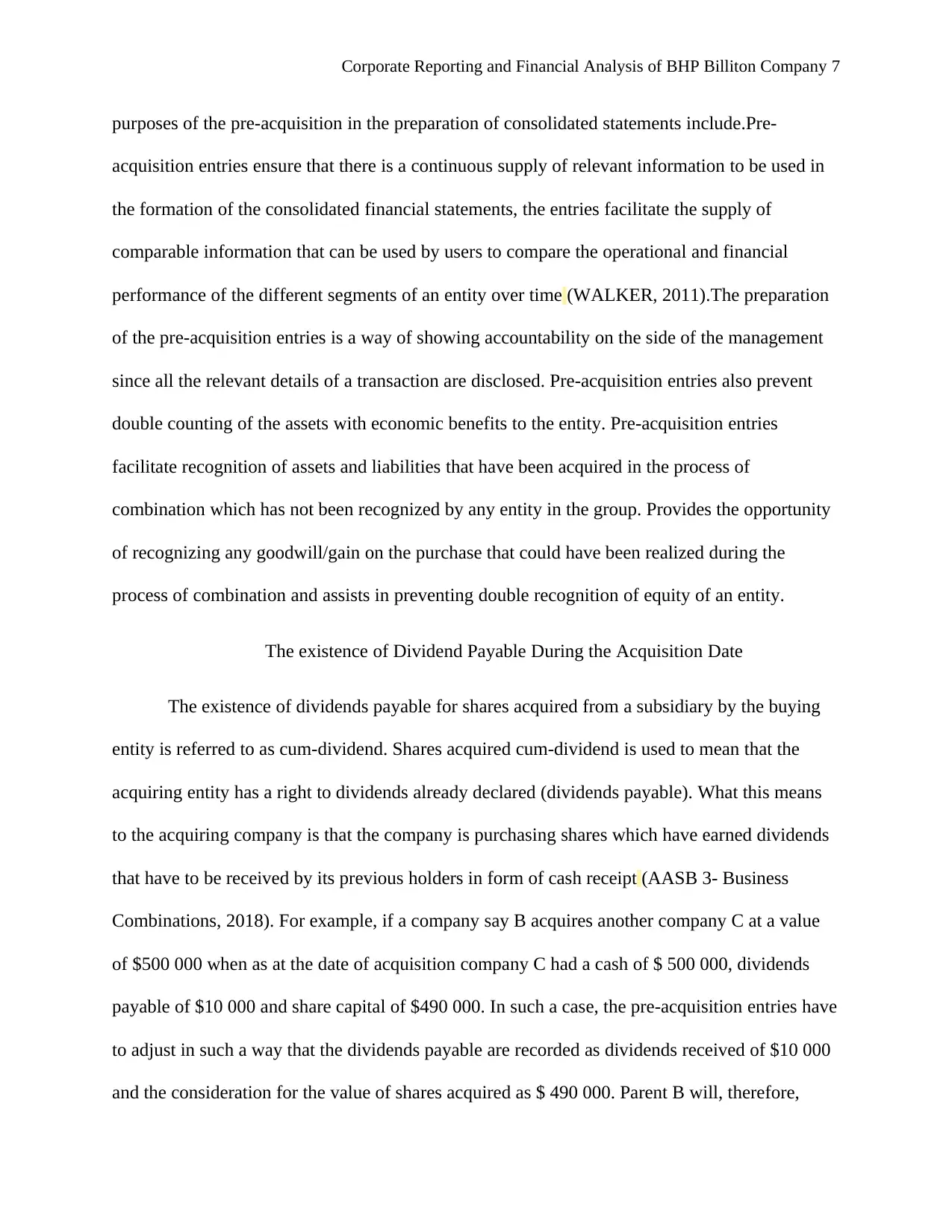
Corporate Reporting and Financial Analysis of BHP Billiton Company 7
purposes of the pre-acquisition in the preparation of consolidated statements include.Pre-
acquisition entries ensure that there is a continuous supply of relevant information to be used in
the formation of the consolidated financial statements, the entries facilitate the supply of
comparable information that can be used by users to compare the operational and financial
performance of the different segments of an entity over time (WALKER, 2011).The preparation
of the pre-acquisition entries is a way of showing accountability on the side of the management
since all the relevant details of a transaction are disclosed. Pre-acquisition entries also prevent
double counting of the assets with economic benefits to the entity. Pre-acquisition entries
facilitate recognition of assets and liabilities that have been acquired in the process of
combination which has not been recognized by any entity in the group. Provides the opportunity
of recognizing any goodwill/gain on the purchase that could have been realized during the
process of combination and assists in preventing double recognition of equity of an entity.
The existence of Dividend Payable During the Acquisition Date
The existence of dividends payable for shares acquired from a subsidiary by the buying
entity is referred to as cum-dividend. Shares acquired cum-dividend is used to mean that the
acquiring entity has a right to dividends already declared (dividends payable). What this means
to the acquiring company is that the company is purchasing shares which have earned dividends
that have to be received by its previous holders in form of cash receipt (AASB 3- Business
Combinations, 2018). For example, if a company say B acquires another company C at a value
of $500 000 when as at the date of acquisition company C had a cash of $ 500 000, dividends
payable of $10 000 and share capital of $490 000. In such a case, the pre-acquisition entries have
to adjust in such a way that the dividends payable are recorded as dividends received of $10 000
and the consideration for the value of shares acquired as $ 490 000. Parent B will, therefore,
purposes of the pre-acquisition in the preparation of consolidated statements include.Pre-
acquisition entries ensure that there is a continuous supply of relevant information to be used in
the formation of the consolidated financial statements, the entries facilitate the supply of
comparable information that can be used by users to compare the operational and financial
performance of the different segments of an entity over time (WALKER, 2011).The preparation
of the pre-acquisition entries is a way of showing accountability on the side of the management
since all the relevant details of a transaction are disclosed. Pre-acquisition entries also prevent
double counting of the assets with economic benefits to the entity. Pre-acquisition entries
facilitate recognition of assets and liabilities that have been acquired in the process of
combination which has not been recognized by any entity in the group. Provides the opportunity
of recognizing any goodwill/gain on the purchase that could have been realized during the
process of combination and assists in preventing double recognition of equity of an entity.
The existence of Dividend Payable During the Acquisition Date
The existence of dividends payable for shares acquired from a subsidiary by the buying
entity is referred to as cum-dividend. Shares acquired cum-dividend is used to mean that the
acquiring entity has a right to dividends already declared (dividends payable). What this means
to the acquiring company is that the company is purchasing shares which have earned dividends
that have to be received by its previous holders in form of cash receipt (AASB 3- Business
Combinations, 2018). For example, if a company say B acquires another company C at a value
of $500 000 when as at the date of acquisition company C had a cash of $ 500 000, dividends
payable of $10 000 and share capital of $490 000. In such a case, the pre-acquisition entries have
to adjust in such a way that the dividends payable are recorded as dividends received of $10 000
and the consideration for the value of shares acquired as $ 490 000. Parent B will, therefore,
Paraphrase This Document
Need a fresh take? Get an instant paraphrase of this document with our AI Paraphraser
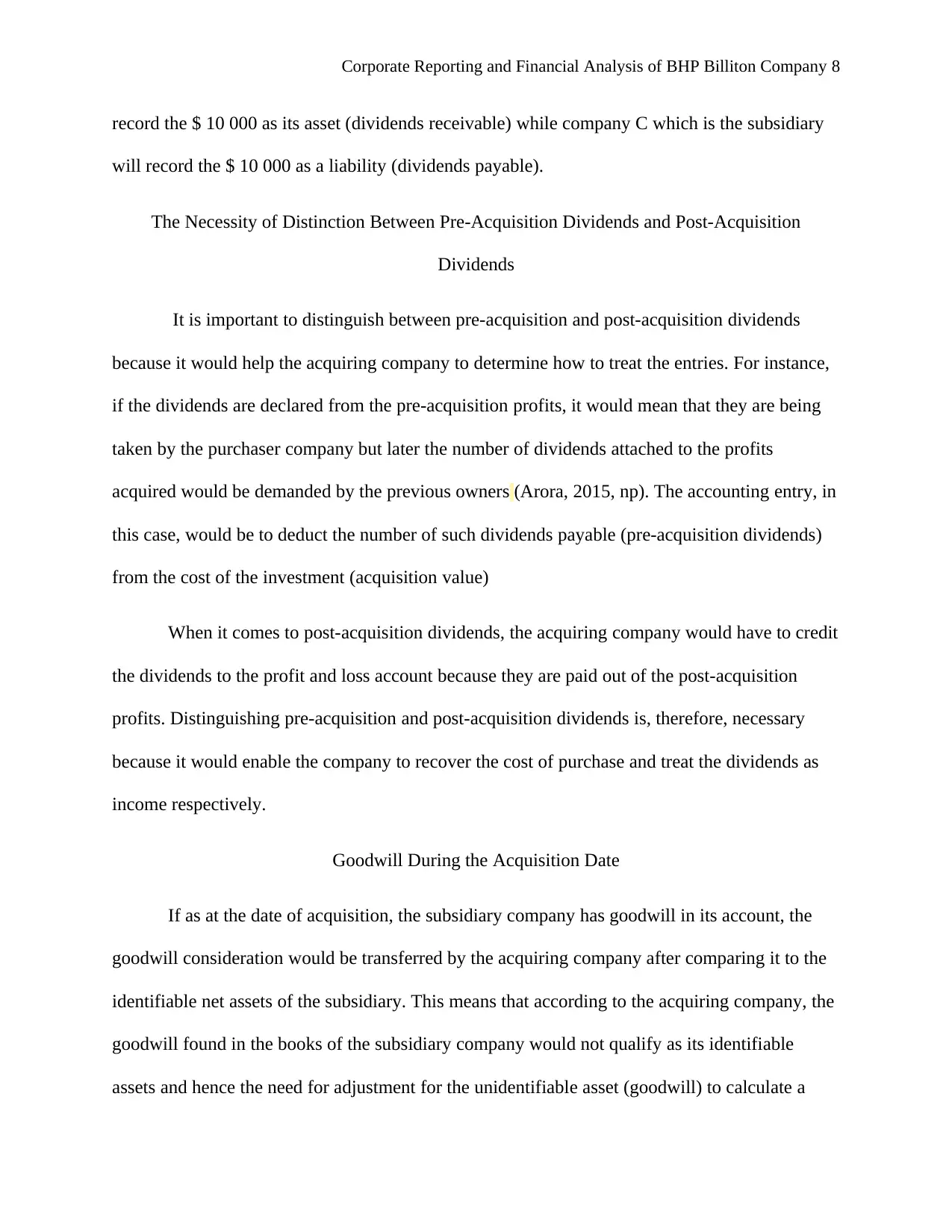
Corporate Reporting and Financial Analysis of BHP Billiton Company 8
record the $ 10 000 as its asset (dividends receivable) while company C which is the subsidiary
will record the $ 10 000 as a liability (dividends payable).
The Necessity of Distinction Between Pre-Acquisition Dividends and Post-Acquisition
Dividends
It is important to distinguish between pre-acquisition and post-acquisition dividends
because it would help the acquiring company to determine how to treat the entries. For instance,
if the dividends are declared from the pre-acquisition profits, it would mean that they are being
taken by the purchaser company but later the number of dividends attached to the profits
acquired would be demanded by the previous owners (Arora, 2015, np). The accounting entry, in
this case, would be to deduct the number of such dividends payable (pre-acquisition dividends)
from the cost of the investment (acquisition value)
When it comes to post-acquisition dividends, the acquiring company would have to credit
the dividends to the profit and loss account because they are paid out of the post-acquisition
profits. Distinguishing pre-acquisition and post-acquisition dividends is, therefore, necessary
because it would enable the company to recover the cost of purchase and treat the dividends as
income respectively.
Goodwill During the Acquisition Date
If as at the date of acquisition, the subsidiary company has goodwill in its account, the
goodwill consideration would be transferred by the acquiring company after comparing it to the
identifiable net assets of the subsidiary. This means that according to the acquiring company, the
goodwill found in the books of the subsidiary company would not qualify as its identifiable
assets and hence the need for adjustment for the unidentifiable asset (goodwill) to calculate a
record the $ 10 000 as its asset (dividends receivable) while company C which is the subsidiary
will record the $ 10 000 as a liability (dividends payable).
The Necessity of Distinction Between Pre-Acquisition Dividends and Post-Acquisition
Dividends
It is important to distinguish between pre-acquisition and post-acquisition dividends
because it would help the acquiring company to determine how to treat the entries. For instance,
if the dividends are declared from the pre-acquisition profits, it would mean that they are being
taken by the purchaser company but later the number of dividends attached to the profits
acquired would be demanded by the previous owners (Arora, 2015, np). The accounting entry, in
this case, would be to deduct the number of such dividends payable (pre-acquisition dividends)
from the cost of the investment (acquisition value)
When it comes to post-acquisition dividends, the acquiring company would have to credit
the dividends to the profit and loss account because they are paid out of the post-acquisition
profits. Distinguishing pre-acquisition and post-acquisition dividends is, therefore, necessary
because it would enable the company to recover the cost of purchase and treat the dividends as
income respectively.
Goodwill During the Acquisition Date
If as at the date of acquisition, the subsidiary company has goodwill in its account, the
goodwill consideration would be transferred by the acquiring company after comparing it to the
identifiable net assets of the subsidiary. This means that according to the acquiring company, the
goodwill found in the books of the subsidiary company would not qualify as its identifiable
assets and hence the need for adjustment for the unidentifiable asset (goodwill) to calculate a
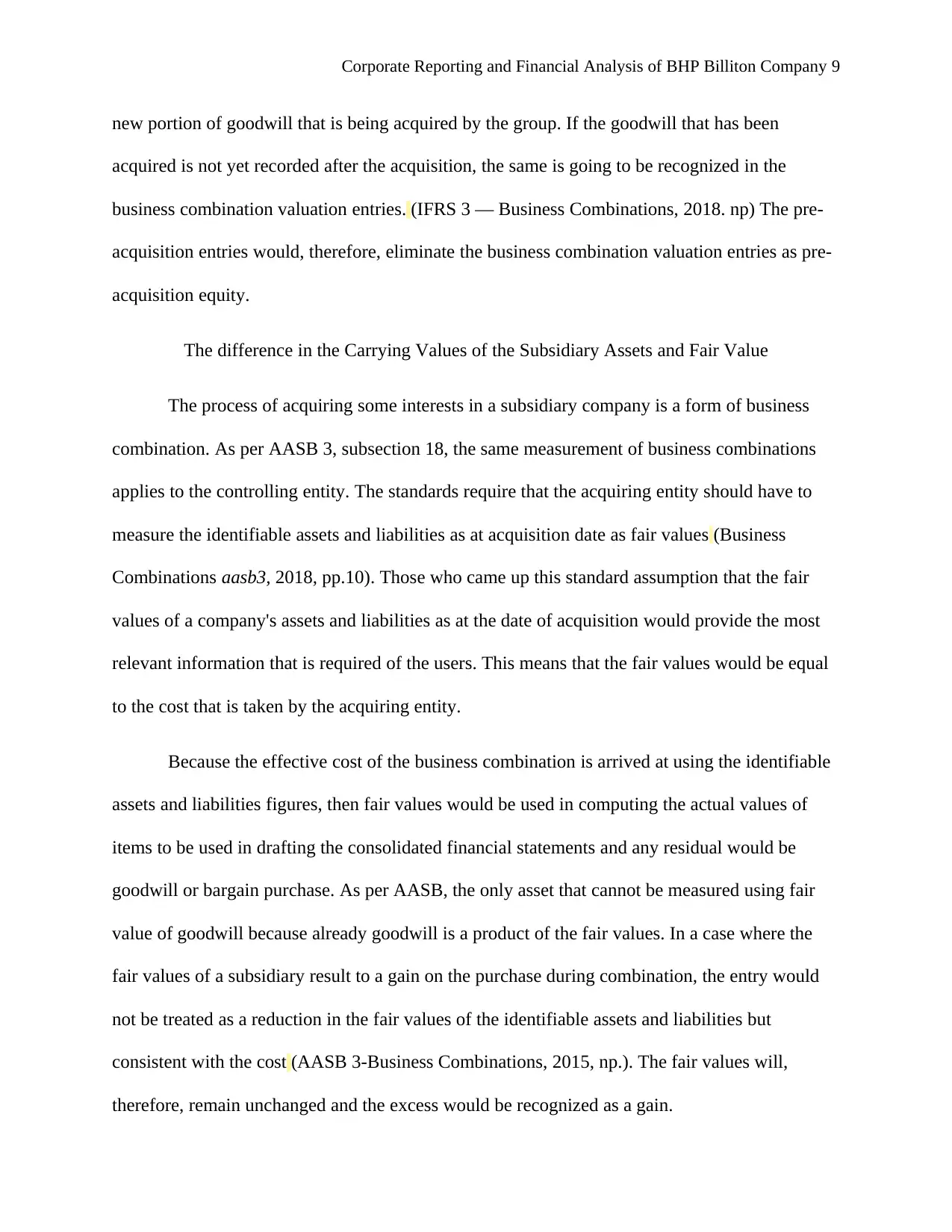
Corporate Reporting and Financial Analysis of BHP Billiton Company 9
new portion of goodwill that is being acquired by the group. If the goodwill that has been
acquired is not yet recorded after the acquisition, the same is going to be recognized in the
business combination valuation entries. (IFRS 3 — Business Combinations, 2018. np) The pre-
acquisition entries would, therefore, eliminate the business combination valuation entries as pre-
acquisition equity.
The difference in the Carrying Values of the Subsidiary Assets and Fair Value
The process of acquiring some interests in a subsidiary company is a form of business
combination. As per AASB 3, subsection 18, the same measurement of business combinations
applies to the controlling entity. The standards require that the acquiring entity should have to
measure the identifiable assets and liabilities as at acquisition date as fair values (Business
Combinations aasb3, 2018, pp.10). Those who came up this standard assumption that the fair
values of a company's assets and liabilities as at the date of acquisition would provide the most
relevant information that is required of the users. This means that the fair values would be equal
to the cost that is taken by the acquiring entity.
Because the effective cost of the business combination is arrived at using the identifiable
assets and liabilities figures, then fair values would be used in computing the actual values of
items to be used in drafting the consolidated financial statements and any residual would be
goodwill or bargain purchase. As per AASB, the only asset that cannot be measured using fair
value of goodwill because already goodwill is a product of the fair values. In a case where the
fair values of a subsidiary result to a gain on the purchase during combination, the entry would
not be treated as a reduction in the fair values of the identifiable assets and liabilities but
consistent with the cost (AASB 3-Business Combinations, 2015, np.). The fair values will,
therefore, remain unchanged and the excess would be recognized as a gain.
new portion of goodwill that is being acquired by the group. If the goodwill that has been
acquired is not yet recorded after the acquisition, the same is going to be recognized in the
business combination valuation entries. (IFRS 3 — Business Combinations, 2018. np) The pre-
acquisition entries would, therefore, eliminate the business combination valuation entries as pre-
acquisition equity.
The difference in the Carrying Values of the Subsidiary Assets and Fair Value
The process of acquiring some interests in a subsidiary company is a form of business
combination. As per AASB 3, subsection 18, the same measurement of business combinations
applies to the controlling entity. The standards require that the acquiring entity should have to
measure the identifiable assets and liabilities as at acquisition date as fair values (Business
Combinations aasb3, 2018, pp.10). Those who came up this standard assumption that the fair
values of a company's assets and liabilities as at the date of acquisition would provide the most
relevant information that is required of the users. This means that the fair values would be equal
to the cost that is taken by the acquiring entity.
Because the effective cost of the business combination is arrived at using the identifiable
assets and liabilities figures, then fair values would be used in computing the actual values of
items to be used in drafting the consolidated financial statements and any residual would be
goodwill or bargain purchase. As per AASB, the only asset that cannot be measured using fair
value of goodwill because already goodwill is a product of the fair values. In a case where the
fair values of a subsidiary result to a gain on the purchase during combination, the entry would
not be treated as a reduction in the fair values of the identifiable assets and liabilities but
consistent with the cost (AASB 3-Business Combinations, 2015, np.). The fair values will,
therefore, remain unchanged and the excess would be recognized as a gain.
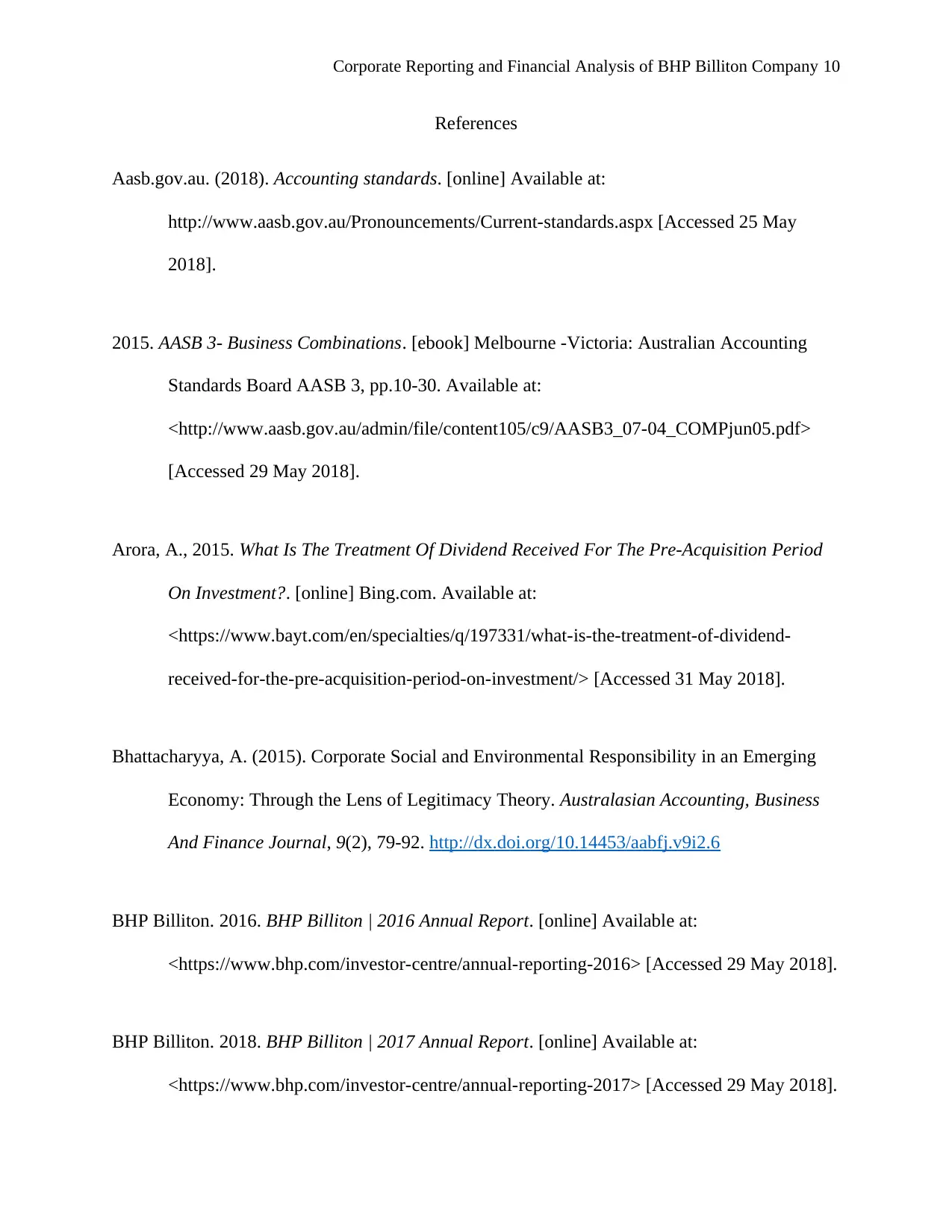
Corporate Reporting and Financial Analysis of BHP Billiton Company 10
References
Aasb.gov.au. (2018). Accounting standards. [online] Available at:
http://www.aasb.gov.au/Pronouncements/Current-standards.aspx [Accessed 25 May
2018].
2015. AASB 3- Business Combinations. [ebook] Melbourne -Victoria: Australian Accounting
Standards Board AASB 3, pp.10-30. Available at:
<http://www.aasb.gov.au/admin/file/content105/c9/AASB3_07-04_COMPjun05.pdf>
[Accessed 29 May 2018].
Arora, A., 2015. What Is The Treatment Of Dividend Received For The Pre-Acquisition Period
On Investment?. [online] Bing.com. Available at:
<https://www.bayt.com/en/specialties/q/197331/what-is-the-treatment-of-dividend-
received-for-the-pre-acquisition-period-on-investment/> [Accessed 31 May 2018].
Bhattacharyya, A. (2015). Corporate Social and Environmental Responsibility in an Emerging
Economy: Through the Lens of Legitimacy Theory. Australasian Accounting, Business
And Finance Journal, 9(2), 79-92. http://dx.doi.org/10.14453/aabfj.v9i2.6
BHP Billiton. 2016. BHP Billiton | 2016 Annual Report. [online] Available at:
<https://www.bhp.com/investor-centre/annual-reporting-2016> [Accessed 29 May 2018].
BHP Billiton. 2018. BHP Billiton | 2017 Annual Report. [online] Available at:
<https://www.bhp.com/investor-centre/annual-reporting-2017> [Accessed 29 May 2018].
References
Aasb.gov.au. (2018). Accounting standards. [online] Available at:
http://www.aasb.gov.au/Pronouncements/Current-standards.aspx [Accessed 25 May
2018].
2015. AASB 3- Business Combinations. [ebook] Melbourne -Victoria: Australian Accounting
Standards Board AASB 3, pp.10-30. Available at:
<http://www.aasb.gov.au/admin/file/content105/c9/AASB3_07-04_COMPjun05.pdf>
[Accessed 29 May 2018].
Arora, A., 2015. What Is The Treatment Of Dividend Received For The Pre-Acquisition Period
On Investment?. [online] Bing.com. Available at:
<https://www.bayt.com/en/specialties/q/197331/what-is-the-treatment-of-dividend-
received-for-the-pre-acquisition-period-on-investment/> [Accessed 31 May 2018].
Bhattacharyya, A. (2015). Corporate Social and Environmental Responsibility in an Emerging
Economy: Through the Lens of Legitimacy Theory. Australasian Accounting, Business
And Finance Journal, 9(2), 79-92. http://dx.doi.org/10.14453/aabfj.v9i2.6
BHP Billiton. 2016. BHP Billiton | 2016 Annual Report. [online] Available at:
<https://www.bhp.com/investor-centre/annual-reporting-2016> [Accessed 29 May 2018].
BHP Billiton. 2018. BHP Billiton | 2017 Annual Report. [online] Available at:
<https://www.bhp.com/investor-centre/annual-reporting-2017> [Accessed 29 May 2018].
Secure Best Marks with AI Grader
Need help grading? Try our AI Grader for instant feedback on your assignments.
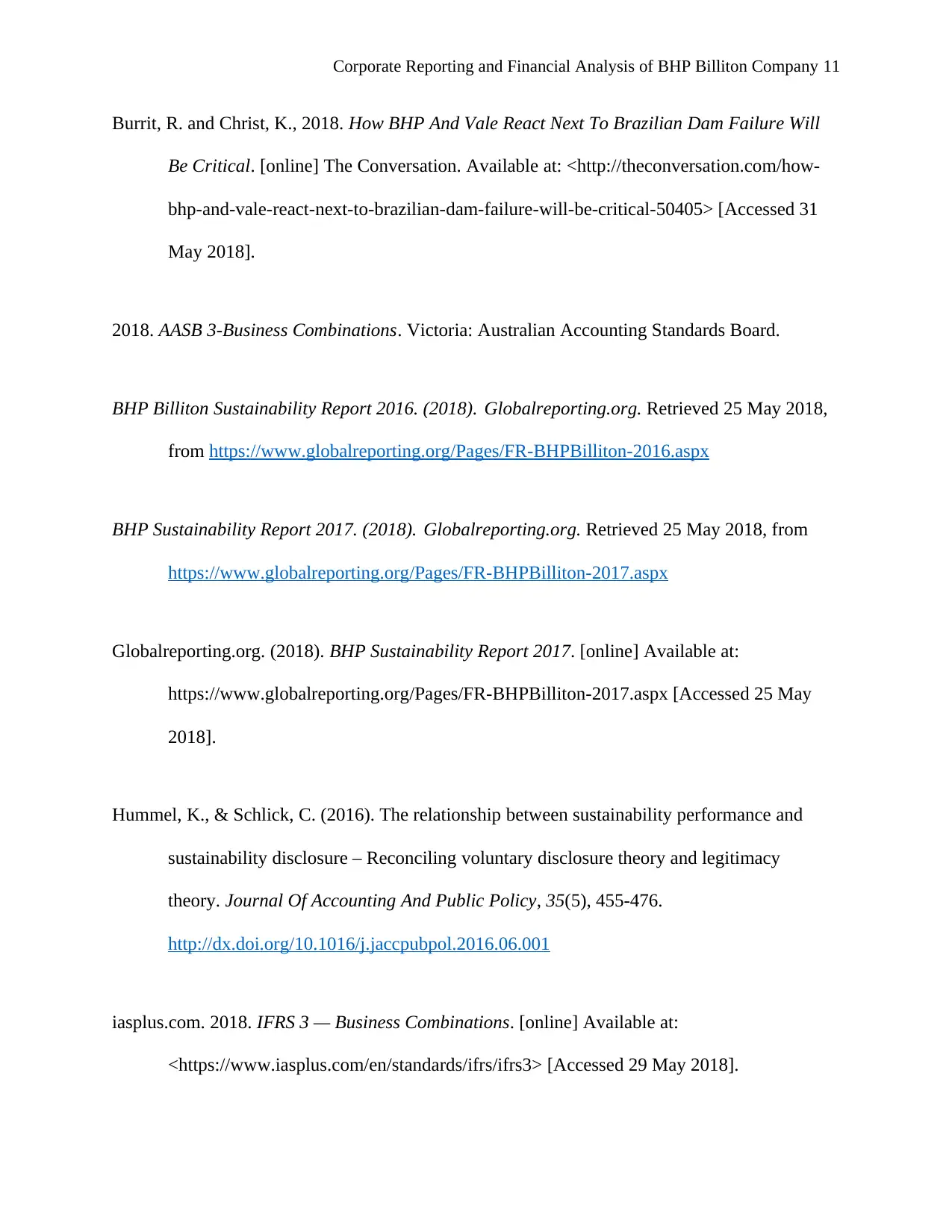
Corporate Reporting and Financial Analysis of BHP Billiton Company 11
Burrit, R. and Christ, K., 2018. How BHP And Vale React Next To Brazilian Dam Failure Will
Be Critical. [online] The Conversation. Available at: <http://theconversation.com/how-
bhp-and-vale-react-next-to-brazilian-dam-failure-will-be-critical-50405> [Accessed 31
May 2018].
2018. AASB 3-Business Combinations. Victoria: Australian Accounting Standards Board.
BHP Billiton Sustainability Report 2016. (2018). Globalreporting.org. Retrieved 25 May 2018,
from https://www.globalreporting.org/Pages/FR-BHPBilliton-2016.aspx
BHP Sustainability Report 2017. (2018). Globalreporting.org. Retrieved 25 May 2018, from
https://www.globalreporting.org/Pages/FR-BHPBilliton-2017.aspx
Globalreporting.org. (2018). BHP Sustainability Report 2017. [online] Available at:
https://www.globalreporting.org/Pages/FR-BHPBilliton-2017.aspx [Accessed 25 May
2018].
Hummel, K., & Schlick, C. (2016). The relationship between sustainability performance and
sustainability disclosure – Reconciling voluntary disclosure theory and legitimacy
theory. Journal Of Accounting And Public Policy, 35(5), 455-476.
http://dx.doi.org/10.1016/j.jaccpubpol.2016.06.001
iasplus.com. 2018. IFRS 3 — Business Combinations. [online] Available at:
<https://www.iasplus.com/en/standards/ifrs/ifrs3> [Accessed 29 May 2018].
Burrit, R. and Christ, K., 2018. How BHP And Vale React Next To Brazilian Dam Failure Will
Be Critical. [online] The Conversation. Available at: <http://theconversation.com/how-
bhp-and-vale-react-next-to-brazilian-dam-failure-will-be-critical-50405> [Accessed 31
May 2018].
2018. AASB 3-Business Combinations. Victoria: Australian Accounting Standards Board.
BHP Billiton Sustainability Report 2016. (2018). Globalreporting.org. Retrieved 25 May 2018,
from https://www.globalreporting.org/Pages/FR-BHPBilliton-2016.aspx
BHP Sustainability Report 2017. (2018). Globalreporting.org. Retrieved 25 May 2018, from
https://www.globalreporting.org/Pages/FR-BHPBilliton-2017.aspx
Globalreporting.org. (2018). BHP Sustainability Report 2017. [online] Available at:
https://www.globalreporting.org/Pages/FR-BHPBilliton-2017.aspx [Accessed 25 May
2018].
Hummel, K., & Schlick, C. (2016). The relationship between sustainability performance and
sustainability disclosure – Reconciling voluntary disclosure theory and legitimacy
theory. Journal Of Accounting And Public Policy, 35(5), 455-476.
http://dx.doi.org/10.1016/j.jaccpubpol.2016.06.001
iasplus.com. 2018. IFRS 3 — Business Combinations. [online] Available at:
<https://www.iasplus.com/en/standards/ifrs/ifrs3> [Accessed 29 May 2018].
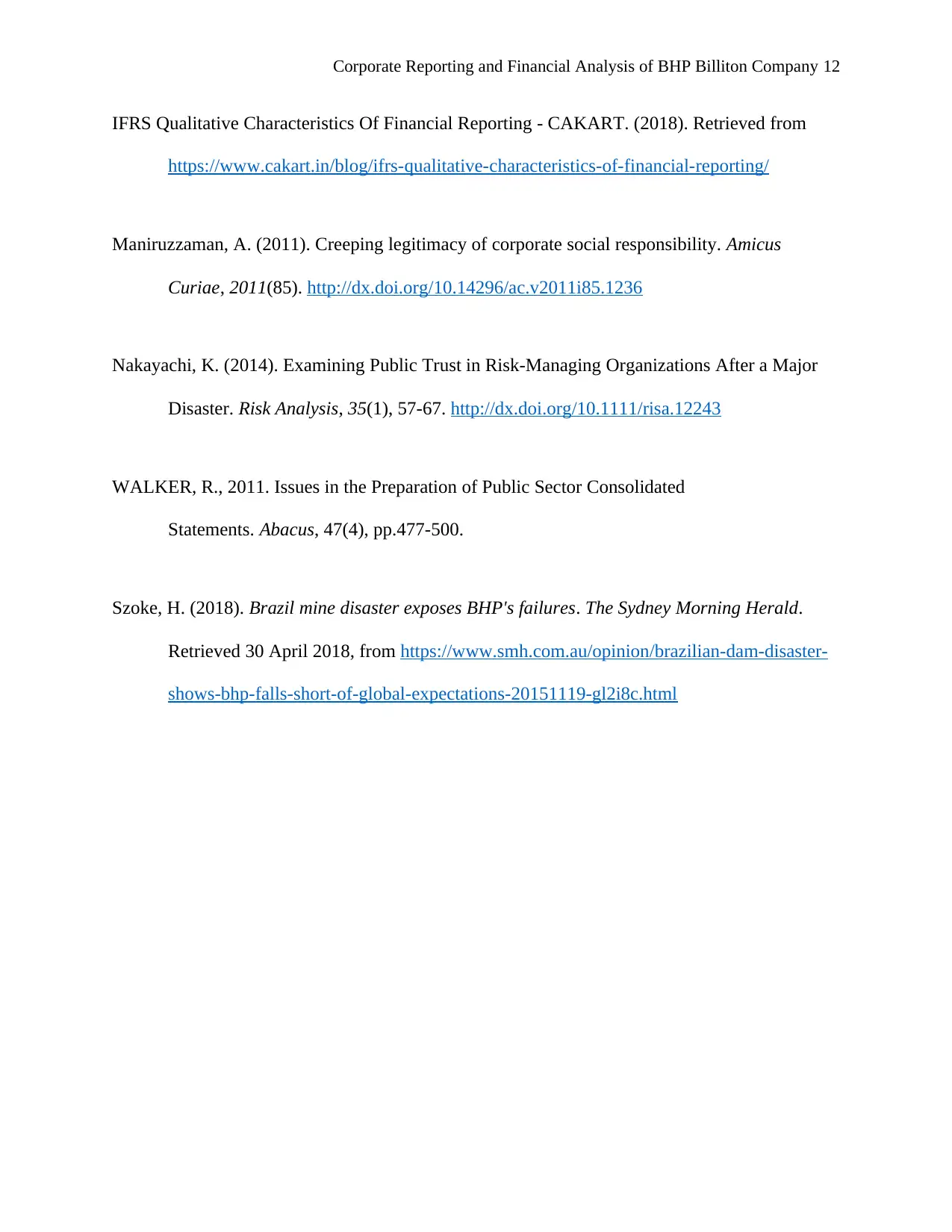
Corporate Reporting and Financial Analysis of BHP Billiton Company 12
IFRS Qualitative Characteristics Of Financial Reporting - CAKART. (2018). Retrieved from
https://www.cakart.in/blog/ifrs-qualitative-characteristics-of-financial-reporting/
Maniruzzaman, A. (2011). Creeping legitimacy of corporate social responsibility. Amicus
Curiae, 2011(85). http://dx.doi.org/10.14296/ac.v2011i85.1236
Nakayachi, K. (2014). Examining Public Trust in Risk-Managing Organizations After a Major
Disaster. Risk Analysis, 35(1), 57-67. http://dx.doi.org/10.1111/risa.12243
WALKER, R., 2011. Issues in the Preparation of Public Sector Consolidated
Statements. Abacus, 47(4), pp.477-500.
Szoke, H. (2018). Brazil mine disaster exposes BHP's failures. The Sydney Morning Herald.
Retrieved 30 April 2018, from https://www.smh.com.au/opinion/brazilian-dam-disaster-
shows-bhp-falls-short-of-global-expectations-20151119-gl2i8c.html
IFRS Qualitative Characteristics Of Financial Reporting - CAKART. (2018). Retrieved from
https://www.cakart.in/blog/ifrs-qualitative-characteristics-of-financial-reporting/
Maniruzzaman, A. (2011). Creeping legitimacy of corporate social responsibility. Amicus
Curiae, 2011(85). http://dx.doi.org/10.14296/ac.v2011i85.1236
Nakayachi, K. (2014). Examining Public Trust in Risk-Managing Organizations After a Major
Disaster. Risk Analysis, 35(1), 57-67. http://dx.doi.org/10.1111/risa.12243
WALKER, R., 2011. Issues in the Preparation of Public Sector Consolidated
Statements. Abacus, 47(4), pp.477-500.
Szoke, H. (2018). Brazil mine disaster exposes BHP's failures. The Sydney Morning Herald.
Retrieved 30 April 2018, from https://www.smh.com.au/opinion/brazilian-dam-disaster-
shows-bhp-falls-short-of-global-expectations-20151119-gl2i8c.html
1 out of 12
Related Documents
Your All-in-One AI-Powered Toolkit for Academic Success.
+13062052269
info@desklib.com
Available 24*7 on WhatsApp / Email
![[object Object]](/_next/static/media/star-bottom.7253800d.svg)
Unlock your academic potential
© 2024 | Zucol Services PVT LTD | All rights reserved.





